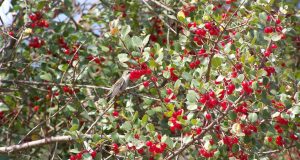Support wildlife, save water, too
Add habitat to your landscape with drought-tolerant shrubs that provide food or shelter for wildlife such as bees, butterflies and birds. Some expert choices that can be planted this fall.
By Debbie Arrington
Guest Writer
Chris Lewis and Robin Rietz know the power of native plants: They’re irresistible – especially to native wildlife.
After all, native plants and native wildlife were made for each other. Native birds, bees and butterflies like to eat the plants where they have always lived; that’s what nature intended.
Near the American River Parkway, Lewis and Rietz grow scores of varieties of wildlife-friendly native plants at the Sac Valley California Native Plant Society (CNPS) Nursery and Gardens. Located on Soil Born Farms’ American River Ranch in Rancho Cordova, the nursery – also known as Elderberry Farms – propagates a wide range of local favorites. Its demonstration gardens show off those native plants year round.
Fall is the best time to transplant most native plants, especially shrubs, trees and perennials. It allows them months (hopefully with rain) to put down roots and get established before the stress of summer heat next year.
“Native plants are not only beautiful and climate adaptable, but they also feed and shelter birds, bees, butterflies and other pollinators,” says Lewis, the nursery’s longtime director.
Gardeners gravitate towards native plants, too; they naturally use less water. Survival of Central California’s dry summer weather is stamped into these plants’ DNA. Many varieties need little if any summer irrigation.
Not only do native plants save water compared to traditional lawn-based landscape, they support local wildlife. Providing flowers and often seeds or berries, native plants offer food for pollinators and birds; that’s something turf never does.
That’s important, notes Lewis. Available habitat and food sources are crucial to native species’ survival.
According to the Audubon Society, the continental United States has lost more than 150 million acres of native plant habitat to urbanization over the past 100 years. That’s devastated the native wildlife that depended on it.
Growing native plants in urban or suburban gardens can help make up for that habitat loss. Otherwise, more species of birds and butterflies will disappear.
“The native plant habitat we protect or add to our landscapes today will determine what life looks like tomorrow,” Lewis says. “We’re all part of the web of life.”
Wildlife, especially birds, needs food sources every season. Otherwise, they leave – or starve. In the CNPS demonstration gardens are examples of native plants that offer something for birds and beneficial insects spring through winter.
This year, the nursery’s team created a new “lawn replacement” demonstration garden that would be acceptable to even picky home owners associations. Says Lewis, “We call it our HOA-friendly garden.”
Rietz, the nursery’s propagation director, planted a mix of perennials, shrubs and small trees that mimic traditional landscaping forms but with a lot more life and color. Birds dart among mountain mahogany and hollyleaf redberry while bees buzz the asters and penstemon. Hummingbirds zip between California fuchsia and scarlet monkeyflower.
“The Sonoma sage is beautiful this summer,” Rietz notes. “It hugs the ground and has nice blue flowers.”
Shrubs and trees give structure to any landscape. They also can provide habitat as well as food for wildlife. At the CNPS nursery, dozens of examples are on display.
Berry-bearing bushes add interest to the landscape, too. In late summer and fall, coffeeberry is loaded with marble-size black berries. Conversely, snowberry lives up to its name with pearl-like berries in fall and winter.
“We try to give ideas of how shrubs can be used in the home landscape,” Rietz says. “For example, the mountain mahogany can be hedged.”
Elderberry can be pruned as a small tree or large shrub, Rietz notes. So can toyon.
“These are mega-pollinator plants,” Lewis adds. “There are lots of winter berries for birds, but when they’re in bloom, bees are all over them. I love shrubs that are multi-functional.”
The demonstration gardens also will be open for viewing; see website for availability.
Sac Valley CNPS Nursery and Gardens are located at Soil Born Farms’ American River Ranch, 2140 Chase Drive, Rancho Cordova.
Debbie Arrington is a longtime home and garden reporter and co-author of the blog Sacramento Digs Gardening: https://sacdigsgardening.blogspot.com/



